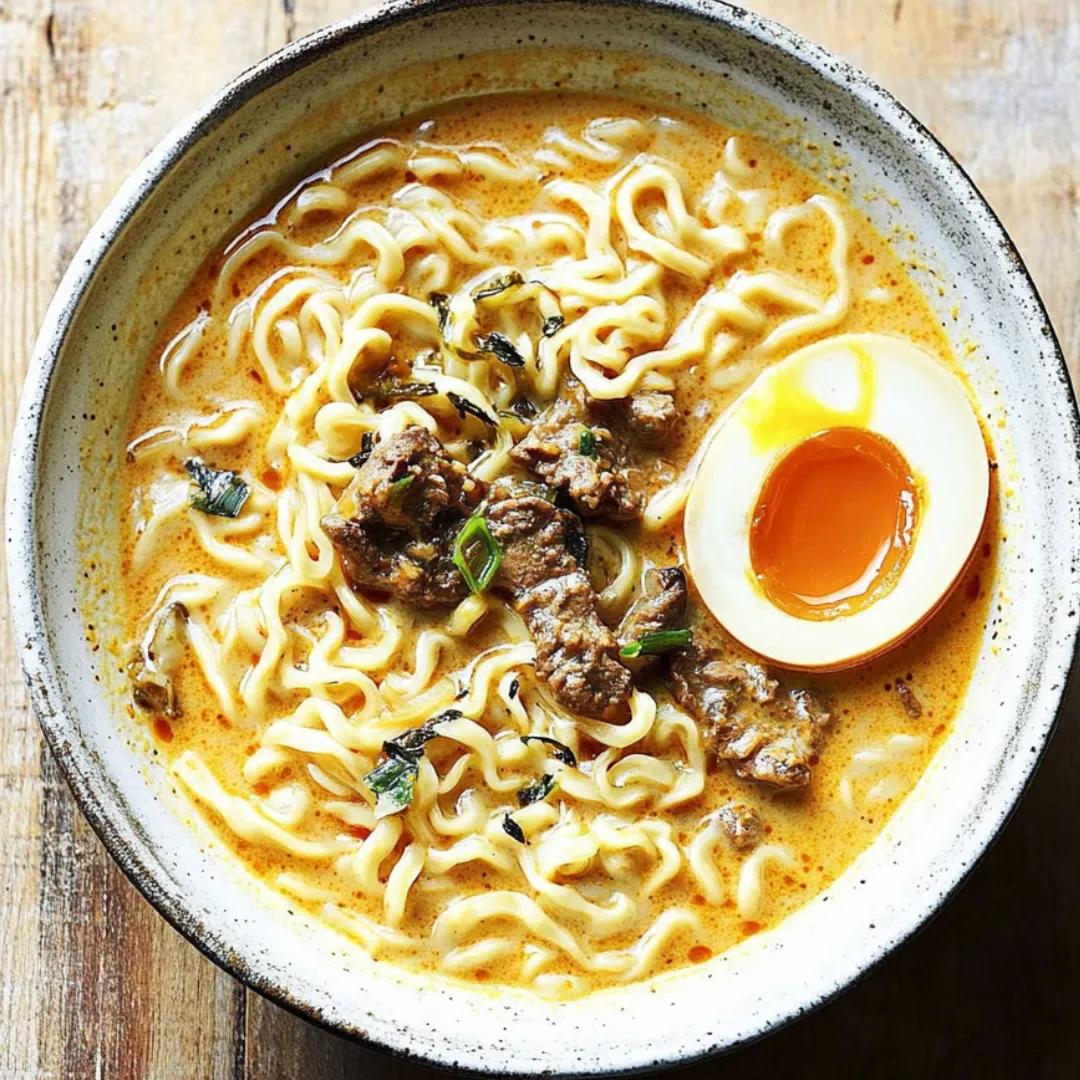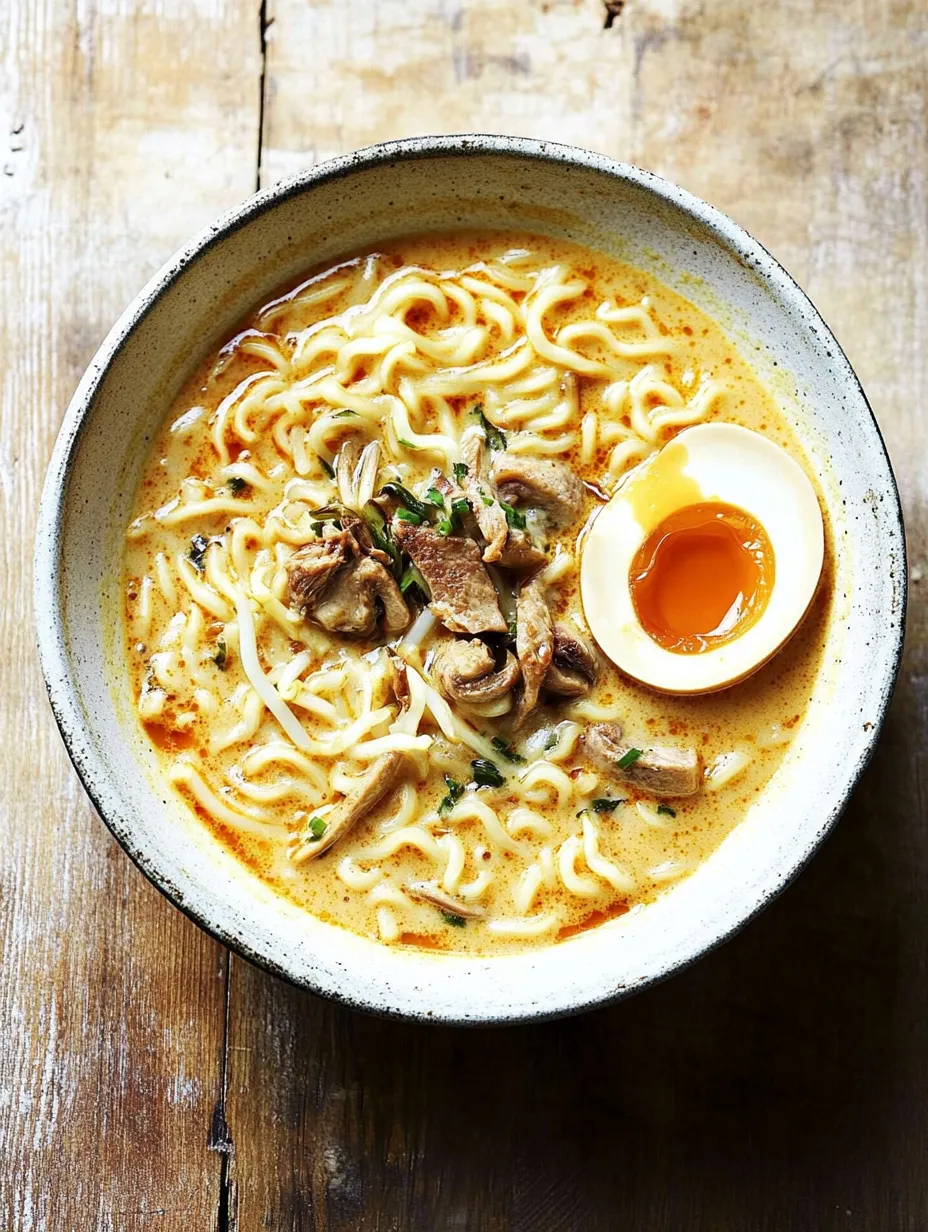 Pin it
Pin it
This quick coconut curry ramen transforms humble instant noodles into something truly extraordinary. The broth - creamy from coconut milk yet vibrant with Thai-inspired flavors - wraps around chewy ramen noodles creating a dish that feels like a warm hug on a cold evening. The crispy shiitakes add wonderful texture while the soft-boiled eggs contribute richness that takes this 20-minute wonder from simple weeknight meal to crave-worthy comfort food. Unlike traditional ramen that simmers for hours, this one-pot ramen recipe delivers deep, complex flavors without the wait.
I discovered this recipe during a particularly cold winter when I was craving something warming but didn't have the energy for an elaborate meal. The first spoonful was a revelation - how could something so quick taste so complex? My family now requests it weekly, and I've made countless variations depending on what's in the fridge. It's become our favorite rainy day tradition.
Ingredients You'll Need
- 3 tbsp Toasted Sesame Oil: Provides that distinctive nutty aroma that's the backbone of many Asian dishes. Use toasted rather than regular sesame oil for deeper flavor
- 3.5 ounces Shiitake Mushrooms: Their meaty texture and earthy flavor add substantial depth. The crispy edges develop amazing umami notes when torn rather than sliced
- 4 Garlic Cloves: Grating rather than chopping releases more oils and flavors. Look for firm bulbs without green sprouts for the cleanest flavor
- 1 tbsp Fresh Ginger: The zingy, spicy notes cut through the richness of the coconut milk. Always use fresh - powdered simply doesn't compare
- 4 cups Chicken or Vegetable Broth: Forms the foundation of your soup. Homemade yields best results, but a good quality store-bought works perfectly
- ½ tsp Ground Turmeric: Adds gorgeous golden color and subtle earthy notes. Plus, it's packed with anti-inflammatory properties
- ½ tsp Brown Sugar: Just enough to balance the acidity and heat without making the broth sweet
- 2 tbsp Low Sodium Soy Sauce: Brings essential umami and salt. Low sodium allows better control over the final seasoning
- 1 tbsp Fish Sauce: Don't skip this! It may smell strong in the bottle, but it adds incredible depth that can't be replicated
- 1 tbsp Sambal Oelek: Provides clean, bright heat without overwhelming the other flavors. Adjust to your spice preference
- 2 tbsp Thai Red Curry Paste: The flavor powerhouse that brings authentic Thai notes to this fusion dish
- 1 can Full-Fat Coconut Milk: Creates that luxurious, velvety texture. Light coconut milk simply won't deliver the same richness
- 1 tbsp Lime Juice: The fresh acidity balances the richness and brings all flavors into focus
- 9 ounces Instant Ramen Noodles: Their bouncy texture is perfect for holding onto the flavorful broth. Discard the seasoning packets
- 4 Soft-Boiled Eggs: The creamy yolks add another dimension of richness. Seven minutes creates that perfect jammy center
 Pin it
Pin it
Step-by-Step Cooking Instructions
- Prep Your Aromatics:
- Before turning on any heat, get all your prep work done. Grate the garlic cloves using a microplane or the smallest holes on a box grater - this releases more flavor than chopping. Do the same with your fresh ginger, making sure to peel it first. Tear your shiitake mushrooms into bite-sized pieces rather than slicing them; the torn edges will get extra crispy and develop more flavor when cooked.
- Crisp the Shiitakes:
- Heat 1 tablespoon of sesame oil in a large pot over medium heat until it shimmers. Add your torn shiitakes in a single layer, giving them space to brown rather than steam. Let them cook undisturbed for about 2 minutes until the edges start to golden. Sprinkle with another tablespoon of sesame oil, season with a pinch of salt and black pepper, then continue cooking until they become properly crispy, about 3-4 more minutes. Remove them from the pot and set aside - these crispy treasures will be your topping.
- Build Your Aromatic Base:
- Reduce the heat to low to prevent burning your aromatics. Add the remaining tablespoon of sesame oil to the same pot, then add your grated garlic and ginger. Cook gently, stirring constantly, until fragrant but not colored, about 1 minute. The aroma should be intoxicating but be careful not to let it brown, which would introduce bitterness.
- Create Your Broth Foundation:
- Pour in the chicken broth, using a wooden spoon to scrape up all those flavorful browned bits from the bottom of the pot. These caramelized remnants from the mushrooms contain concentrated umami that will elevate your broth. Bring this mixture to a gentle boil.
- Layer In The Flavors:
- Once boiling, add the turmeric (watch your wooden spoons - they'll stain!), brown sugar, soy sauce, and fish sauce. Stir well to dissolve the sugar. Now add the red curry paste and sambal oelek, adjusting the amount based on your heat preference. Whisk thoroughly to ensure the curry paste completely dissolves into the broth with no lumps.
- Add Richness:
- Pour in the coconut milk, stirring gently to incorporate it without breaking the fat emulsion. Squeeze in the fresh lime juice - this bright acidity will balance the rich coconut milk and spicy elements. Let the broth return to a simmer, tasting and adjusting seasonings if needed.
- Cook The Noodles:
- Once your broth is simmering, add the ramen noodles directly to the pot. Push them down gently to submerge them in the broth. Cook for exactly 2 minutes, or until just tender but still slightly firm. If you're not serving immediately, cook the noodles separately and add them just before serving to prevent them from absorbing too much broth and becoming soggy.
- Serve With Flair:
- Ladle the hot ramen and broth into deep bowls. Top each serving with your crispy shiitakes, a halved soft-boiled egg, a sprinkle of sesame seeds, and freshly chopped chives. Drizzle with chili oil for extra heat and visual appeal. Serve immediately while steaming hot, with extra lime wedges on the side.
Last winter, my daughter caught a nasty cold that left her without much appetite. This ramen was the first thing she would eat after days of barely touching food. She swears the aromatic broth 'fixed her nose' and helped her taste again. Whether it was the steam, the spice, or just comfort food magic, I've been making this whenever anyone feels under the weather. It's become our family's chicken soup equivalent - the food we turn to when we need care in a bowl.
The Art of the Perfect Soft-Boiled Egg
Creating that ideal jammy-centered egg elevates this ramen from good to exceptional. Start with eggs straight from the refrigerator and gently lower them into already-boiling water. Set your timer for exactly 7 minutes for that perfect balance of set whites and creamy yolks. While they cook, prepare an ice bath. When the timer rings, immediately transfer the eggs to the ice water to stop the cooking process. This temperature shock also makes peeling easier. Once cooled for about 5 minutes, gently tap and roll the egg on a hard surface to crack the shell all over, then peel under a thin stream of cold water. Slice in half just before serving to reveal that gorgeous golden center.
Adapting to Dietary Needs
This versatile recipe easily accommodates various dietary restrictions without sacrificing flavor. For a vegetarian version, simply use vegetable broth instead of chicken and omit the fish sauce, adding an extra tablespoon of soy sauce and a teaspoon of rice vinegar to maintain depth. Going gluten-free? Swap the ramen noodles for rice noodles or 100% buckwheat soba. The broth itself is already gluten-free if you use tamari instead of soy sauce. For those avoiding eggs, add cubed tofu or edamame for protein. The core flavor profile remains intact regardless of these modifications.
Making It Ahead
While this ramen comes together quickly, you can streamline dinner even further by preparing components in advance. The broth (without noodles) keeps beautifully in the refrigerator for up to three days, actually improving in flavor as it sits. The crispy shiitakes can be made a day ahead and stored in an airtight container at room temperature - just refresh them in a dry skillet for 30 seconds before serving. Soft-boiled eggs can be prepared up to two days in advance and kept (unpeeled) in the refrigerator. When ready to serve, simply reheat the broth, cook fresh noodles, and assemble your bowls.
The Importance of Layering Flavors
What makes this quick ramen taste so complex is the careful layering of flavors. Each ingredient enters the pot at a specific time to maximize its contribution. The sesame oil and shiitakes create a foundation of roasted, nutty notes. The aromatics add their fragrant punch before the liquid components. The soy sauce and fish sauce bring umami depth, while the curry paste introduces complexity. Finally, the coconut milk smooths everything out, and the lime juice brightens the finished dish. This method of building flavors is what separates a great soup from a merely good one.
 Pin it
Pin it
Seasonal Variations
Like any great recipe, this ramen adapts beautifully to seasonal produce. In spring, add tender asparagus tips and sweet peas during the last minute of cooking. Summer calls for corn kernels and cherry tomatoes that burst in the hot broth. Fall welcomes diced butternut squash or sweet potato (add them with the broth to ensure they cook through). Winter greens like kale or chard wilt perfectly into the hot soup just before serving. By following the seasons, you'll never get bored with this versatile dish.
After years of experimenting with quick weeknight meals, this spicy coconut curry ramen remains my most reliable crowd-pleaser. There's something almost magical about how such complex flavors develop in so little time. What began as a simple solution to weeknight dinner fatigue has become the dish friends and family request most often. I think the secret lies in the balance - creamy yet spicy, complex yet comforting, exotic yet familiar. Whether you make it exactly as written or adapt it to what's in your pantry, this recipe delivers that rare combination of minimal effort and maximum satisfaction. It reminds me that sometimes the most nourishing meals aren't the most complicated - they're the ones made with care and shared with people you love.
Frequently Asked Questions
- → Can I make this recipe vegan?
- Yes, simply use vegetable broth instead of chicken broth, omit the fish sauce (substitute with more soy sauce or add a bit of miso paste), and skip the eggs. You can add tofu or more vegetables for protein.
- → What protein options work well with this ramen?
- This versatile dish works great with sliced chicken breast, shrimp, tofu, or thinly sliced beef. Cook proteins separately and add them at the end to prevent overcooking.
- → Can I prepare components ahead of time?
- Yes! The broth can be made a day ahead and refrigerated. Cook noodles separately when ready to serve. Crispy mushrooms can be made ahead but will lose some crispness when stored.
- → What if I don't have sambal oelek?
- Substitute with sriracha, gochujang, or any chili paste you have. Even red pepper flakes work in a pinch, though the flavor profile will be slightly different.
- → What vegetables can I add to this ramen?
- Great additions include bok choy, spinach, snow peas, sliced bell peppers, bean sprouts, or corn. Add leafy greens at the very end, and harder vegetables earlier so they have time to soften.
